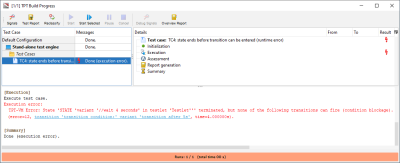Test Termination and State Termination
This example illustrates different ways of terminating a trial in TPT. Open the file Help|Examples|02 Test Modeling|09 Test Termination and State Termination. Select each test case in the Project view and read the text in the text boxes in the Content view.
Test termination example
There are already some automaton elements, most importantly the testlet and the final transition. Since the test will terminate when the final junction state is reached, we have to look at the previous automaton state to check when and why it terminates.
A step state will always be terminated once all steps within the testlet are executed. However, if there is no time-consuming step in the step list, it will not terminate its state without further influence. The test will be terminated in a state whenever the timeout specified in the Platform Configuration dialog is reached (default is 60 s).
Another way to terminate a state is to fulfill the adjacent transition condition. This will always override any conditions from within the step list. If there is no transition condition specified (default), the transition will not influence the automaton state.
Double click any transition to open the transition specification. From there, you can change edit or create new transition specifications.
Open transition specification
The six test cases illustrate five different ways of terminating an automaton and one which does not work. The state ends before transition can be entered (runtime error) test case will cause a runtime error because the step list in the state is terminated after 4 s but the transition condition does not allow the automation to go on the final junction before 5 s.
Runtime error
Related topics


